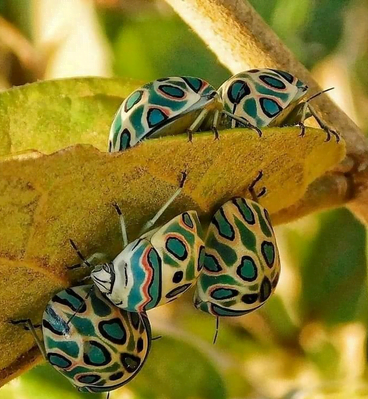The Picasso bug is one of the most stunning insects on the globe. It proudly bears the surname of one of history’s famous painters, Pablo Picasso. These bugs are so beautiful that many people feel they were painted by the famous Picasso himself. Let’s have a look at some fun facts bout the Picasso bugs.
Phylum: Arthropoda
Class: Insecta
Order: Hemiptera
Genus: Sphaerocoris
Family: Scutelleridae
1. The Picasso bug is a masterpiece of art
Because of the stunning hues that adorn its shell, the Picasso bug is possibly one of the most gorgeous insects on earth. It is distinguished by its gorgeous shield-shaped back. The species is also known as Zulu hud bug or Sphaerocoris annulus. It is a member of the jewel bug Scutelleridae family.
Its color pallet varies from a beige base to more intricate designs in orange, red, green, and black. When looking at them, you might think that they are Picasso’s works. That explains why the species are called so.

They may look the same, but there are no two Picasso bugs that have exactly the same pattern. This’s similar to Zebra with their stripe pattern.
With all those beautiful colors, they can blend easily into their environments. Due to their camouflage and their small sizes (only 8 millimeters long), they are difficult to spot in the wild.

Like other colorful bugs, the vivid colors of these insects are not for only show. Those vibrant colors and detailed designs are signs to warn predators to stay away from them. In nature, most species have the instinct to let them know that brightly colored insects are usually more toxic and dangerous.
Picasso bugs are also closely related to the stink bug. As a result, when frightened or disturbed, they can expel foul-smelling material in order to frighten off predators. They are also poisonous if eaten.
Picasso bugs are among the most beautiful insects on earth, you may find more related articles here:
2. They’re often mistaken for beetles
Picasso bug is one of the arthropod species. It is one of the members of 450 known species in the Scutelleridae (or Shield-Backed Bug) family. All the members of this family have a distinctive enlargement on their back (the thoracic scutellum) frequently causes them to be mistaken for beetles.
The scutellum, however, is a portion of the insect’s body that extends from the belly to the rear. In contrast, beetles only have the hardened wing area. The scutellum wraps both the wings and abdomen in one piece. This is quite different than other bugs and beetles.

Because there is no separation in the middle of the scutellum, they don’t ‘split open’ when the Picasso bugs fly. Due to this feature, the Picasso bugs don’t want to fly at all, although they can do it and they do it pretty skillfully.
Another significant distinction between beetles and Scutelleridae insects is their wings. Whereas beetles have only two membranous wings, jewel bugs have four beneath their protective shield.
The animal is not on the IUCN’s Red List of Threatened Species. However, because of habitat destruction and global warming, it has the potential to become an endangered species.
3. They’re from Africa
The gorgeous Picasso bugs are native to a significant part of the entire planet. They are found primarily in Africa, specifically South Africa, Cameroon, Ghana, Nigeria, Zimbabwe, Ethiopia, etc. These are merely a few of the nations where it can be found.

It looks like a forest-dwelling insect. However, they don’t. These tiny, yet captivating, insects live in a habitat that may surprise you. They prefer dry, arid environments, such as in the sub-Saharan regions.
4. Diet
Those brightly colored insects, like many of their relatives, are completely herbivorous. However, they eat mostly the juices of various plants. And certain commercial crops are among them. With their sucking and cutting proboscis, these invertebrates can easily feed on nectar and juice.

They are eaten by other insects, spiders, and insectivores.
5. Life cycle
Every insect has to go through a metamorphosis process. It could be complete or incomplete metamorphosis.
A complete metamorphosis means that the insect has to pass through 4 different phases: egg – larvae – pupa – adult. The butterfly is a typical example of complete metamorphosis. However, in incomplete metamorphosis, the insect will skip the pupa stage. The Picasso Bug is a classic example of this kind of metamorphosis.
They begin life as an egg, which is laid on the underside of the leaves. The eggs hatch to Picasso nymphs which are more creamy yellow colored with black bands and spots. Their colors are quite different than the adults. However, their basic shape remains constant throughout their lives.

The immature nymphs spend their time eating flowers. For under 2 months (around 56 days), they molt and develop into adults. At this time, their color changes, and they gain wings. When becoming adults, Picasso bugs eat more variety of plants. Like other bugs, the Picasso insect has a short lifespan. Their mating season occurs in the dry season, from November to December.
Conclusion
The Picasso bug is fascinating and stunning due to its relatively small size, its gorgeous coloration, and the fact that scientists still don’t know much about it. As researchers learn more about this bug and its relatives, they may be able to help conserve some of the world’s most important art pieces.
Reference:
- Picasso Bug https://www.ourbreathingplanet.com/?p=5885
- The Picasso Bug, a living work of art that embellishes nature – https://culturacolectiva.com/technology/picasso-bug-sphaerocoris-annulus-facts/

